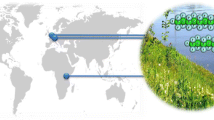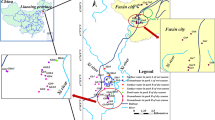Abstract
The Brick Township Municipal Utilities Authority (BTMUA), which relies on the Metedeconk River as its primary source of water supply, initiated a perfluoroalkyl acid (PFAA) source trackdown study in collaboration with the New Jersey Department of Environmental Protection (NJDEP) after discovering that the concentration of one PFAA, perfluorooctanoic acid (PFOA), was elevated at their raw surface water intake. Water samples were collected over eight sampling events between September 2011 and July 2014. Samples included surface water, groundwater, stormwater, sanitary sewer water, and commercial/industrial process water. Each sample was analyzed for ten PFAAs. Results from a set of samples collected from the 80 km2 South Branch Metedeconk River watershed directed the focus of this study to a 7.5-km2 area of interest. Within this area, a high concentration of PFAA contamination was documented in a localized zone. Subsequent groundwater sampling led to the identification of a plume of groundwater contamination emanating from an industrial/business park. The suspected source of PFAA detected in the river and drinking water intake was identified to a small industrial facility that used materials containing PFOA. Groundwater PFOA concentrations as high as 70,000 ng/L were found in samples taken within 200 m of the parcel and surface water concentrations as high as 130 ng/L were observed in the river. While various PFAAs were detected in the samples, particularly in groundwater samples, PFOA was identified as the primary contaminant of concern with respect to the river and the BTMUA water supply.



Similar content being viewed by others
References
Ahrens L (2011) Polyfluoroalkyl compounds in the aquatic environment: a review of their occurrence and fate. J Environ Monit 13:20–31
Benskin JP, Ahrens L, Muir DCG, Scott BF, Spencer C, Rosenberg B, Tomy G, Kylin H, Lohmann R, Martin JW (2012) Manufacturing origin of perfluorooctanoate (PFOA) in Atlantic and Canadian Arctic seawater. Environmental Science & Technology 46:677–685
Davis KL, Aucoin MD, Larsen BS, Kaiser MA, Hartten AS (2007) Transport of ammonium perfluorioocatanoate in environmental media near a fluoropolymer manufacturing facility. Chemosphere 67:2011–2019
Eschauzier C, Beerendonk E, Scholte-Veenendaal P, De Voogt P (2012) Impact of treatment processes on the removal of perfluoroalkyl acids from the drinking water production chain. Environmental Science & Technology 46:1708–1715
Ferrey ML, Wilson JT, Adair C, Su C, Fine DD, Liu X, Washington JW (2012) Behavior and fate of PFOA and PFOS in sandy aquifer sediment. Groundwater Monitoring & Remediation 32:63–71
Helsel DR (2012) Statistics for censored environmental data using Minitab and R, 2nd edn. Wiley, Hoboken
Lindstrom AB, Strynar MJ, Libelo EL (2011) Polyfluorinated compounds: past, present, and future. Environmental Science & Technology 45:7954–7961
Moody CA, Hebert GN, Strauss SH, Fields JA (2003) Occurrence and persistence of perfluorooctanesulfonate and other perfluorinated surfactants in groundwater at a fire-training area at Wurtsmith Air Force Base, Michigan, USA. J Environ Manag 5:341–345
New Jersey Department of Environmental Protection (NJDEP) (2007a) Determination of perfluorooctanoic Acid (PFOA) in aqueous samples. Final Report. Trenton. www.nj.gov/dep/watersupply/pdf/final_pfoa_report.pdf. Accessed 29 Mar 2017
New Jersey Department of Environmental Protection (NJDEP) (2007b) Guidance for PFOA in drinking water at Pennsgrove Water Supply Company. Memorandum. Trenton. http://www.nj.gov/dep/watersupply/dwc_quality_pfoa.html. Accessed 29 Mar 2017
New Jersey Department of Environmental Protection (NJDEP) (2009) Status of NJDEP PFOA activities—8/8/09. Trenton. http://www.state.nj.us/dep/dsr/pfoa_doc.pdf. Accessed 29 Mar 2017
New Jersey Department of Environmental Protection (NJDEP) (2014) Occurrence of perfluorinated chemicals in untreated New Jersey drinking water sources. Final Report. Trenton. www.nj.gov/dep/watersupply/pdf/pfc-study.pdf. Accessed 29 Mar 2017
New Jersey Department of Environmental Protection (NJDEP), Office of Information Resources Management (OIRM), Bureau of Geographic Information Systems (BGIS) (2015) Land Use/Land Cover 2012 Update, Edition 20150217 Subbasin 02040301—Mullica-Toms. NJ Department of Environmental Protection (NJDEP), Trenton, NJ. http://nj.gov/dep/gis/lulc12.html. Accessed 29 Mar 2017
New Jersey Drinking Water Quality Institute (NJDWQI) (2017a) Health-based maximum contaminant level support document: perfluorooctanoic acid (PFOA). Appendix A. http://www.nj.gov/dep/watersupply/pdf/pfoa-appendixa.pdf. Accessed 29 Mar 2017
New Jersey Drinking Water Quality Institute (NJDWQI) (2017b) Maximum contaminant level recommendation for perfluorooctanoic acid in drinking water: Basis and background. http://www.nj.gov/dep/watersupply/pdf/pfoa-recommend.pdf. Accessed 29 March 2017
Newel WL, Powars DS, Owens JP, Stanford SD, Stone BD (2000) Surficial geologic map of central and southern New Jersey. U. S Geological Survey Miscellaneous Investigations Series. Map I-2540-D
Oliaei F, Kriens D, Weber R (2010) Discovery and investigation of PFOS/PFCs contamination from a PFC manufacturing facility in Minnesota—environmental releases and exposure risks. Organohalogen Compd 72:1338–1341
Oliaei F, Kriens D, Weber R, Watson A (2013) PFOS and PFC releases and associated pollution from a PFC production plant in Minnesota (USA). Environ Sci Pollut Res 20:1977–1992
Owens JP, Sugaman PJ, Sohl NF, Parker RA, Houghton HF, Volkort RA, Drake AA, Orndorf RC (1998) Bedrock geologic map of central and southern New Jersey. U. S Geological Survey Miscellaneous Investigations Series. Map I-2540-B
Post GB, Louis JB, Cooper KR, Boros-Russo BJ, Lippincott RL (2009) Occurrence and potential significance of perfluorooctanoic acid (PFOA) detected in New Jersey public drinking water systems. Environ Sci Technol 43:4547–4554
Post GB, Cohn PD, Cooper KR (2012) Perfluorooctanoic acid (PFOA), an emerging drinking water contaminant: a critical review of recent literature. Environ Res 116:93–117
Post GB, Louis JB, Cooper KR, Boros-Russo BJ, Lippincott RL, Procopio NA (2013) Occurrence of perfluorinated chemicals in raw water from New Jersey public drinking water systems. Environ Sci Technol 47:13266–13275
Shoemaker JA, Grimmett PE, Boutin BK (2009) Method 537. Determination of selected perfluorinated alkyl acids in drinking water by solid phase extraction and liquid chromatography/tandem mass spectrometry (LC/MS/MS) version 1.1. U.S. Environmental Protection Agency, Washington, DC
Strynar ML (2014) Analysis of Brick Township NJ water samples for PFCs. USEPA National Exposure Research Laboratory, North Carolina Personal communication 24 July 2014
Szabo Z, Jacobsen E, Kraemer TF, Parsa B (2008) Concentrations and environmental fate of Ra in cation-exchange regeneration brine waste disposed to septic tanks and accumulation in sludge, New Jersey Coastal Plain, USA. J Environ Radioact 99:947–964
Takagi S, Adachi F, Miyano K, Koizumi Y, Tanaka H, Mimura M, Watanabe I, Tanabe S, Kannan K (2008) Perfluorooctanesulfonate and perfluorooctanoate in raw and treated tap water from Osaka, Japan. Chemosphere 72:1409–1412
U.S. Census Bureau (2010) Census Blocks (2010) in New Jersey, Edition 20140523. U.S. Department of Commerce, U.S. Census Bureau, Geography Division Washington DC
U.S. Department of Agriculture, Natural Resources Conservation Service (2006) Field indicators of hydric soils in the United States, version 6.0. G.W. Hurt and L.M. Vasilas (eds.). USDA, NRCS, in cooperation with the National Technical Committee for Hydric Soils https://nrcspad.sc.egov.usda.gov/DistributionCenter/pdf.aspx?productID=663
U.S. Department of. Agriculture (2013) Soil Survey Geographic (SSURGO) database for Monmouth and Camden Counties, New Jersey. U.S. Department of Agriculture, Natural Resources Conservation Service, Fort Worth, TX
U.S. Environmental Protection Agency (EPA) (2016) Drinking water health advisory for perfluorooctanoic acid (PFOA). EPA Document Number 822-R-16-005. 103 pages. Washington, DC. https://www.epa.gov/sites/production/files/2016-05/documents/pfoa_health_advisory_final_508.pdf. Accessed 24 Mar 2017
Watt MK, Johnson ML, Lacombe PJ (1994) Hydrology of the unconfined aquifer system, Toms River, Metedeconk River, and Kettle Creek Basins, New Jersey, 1987–1990. U.S. Geological Survey Water Resources Investigations. Report 93–4110
Xiao F, Simcik MF, Halbach TR, Gulliver JS (2015) Perfluorooctane sulfanate (PFOS) and perfluorooctanate (PFOA) in soils and groundwater of a U.S. metropolitan area: migration and implications for human exposure. Water Res 72:64–75
Acknowledgements
The authors are grateful to the following individuals and organizations for their assistance with the project: Gary Buchanan, Gloria Post, and Lee Lippincott of the NJDEP DSREH; Karl Muessig, Raymond Bousenberry, and Gregg Steidl of the New Jersey Geological & Water Survey; Mark Strynar and Andrew Lindstrom of the USEPA National Exposure Research Laboratory; BTMUA Board of Commissioners; James Lacey, Glenn Hamelink, Joseph DiMatteo, Shari Kondrup, Michael Planko, John Rouse, and Will Ruocco of the Brick Township MUA; Michael Willis and William Suchodolski of the Ocean County Utilities Authority; Thomas French of Eurofins Eaton Analytical, Inc.; Michael Mangum and Ernest Kuhlwein of Ocean County; Michael Espinoza of JCP&L; Brett Vanderford and Eric Dickenson of the Southern Nevada Water Authority; Daniel O’Rourke of CDM Smith; Brian Kokot of Environmental Probing Investigations, Inc.; and Larry Doyle of Berkeley HazMat. Access to sampling locations was kindly provided by Lakewood Township, Lakewood Industrial Commission, Ocean County, Ocean County Utilities Authority, and JCP&L. The findings and conclusions in this article are those of the authors and do not necessarily represent the views of the NJDEP or BTMUA.
Author information
Authors and Affiliations
Corresponding author
Additional information
Responsible editor: Ester Heath
Electronic supplementary material
ESM 1
(DOCX 22 kb)
Rights and permissions
About this article
Cite this article
Procopio, N.A., Karl, R., Goodrow, S.M. et al. Occurrence and source identification of perfluoroalkyl acids (PFAAs) in the Metedeconk River Watershed, New Jersey. Environ Sci Pollut Res 24, 27125–27135 (2017). https://doi.org/10.1007/s11356-017-0309-3
Received:
Accepted:
Published:
Issue Date:
DOI: https://doi.org/10.1007/s11356-017-0309-3




